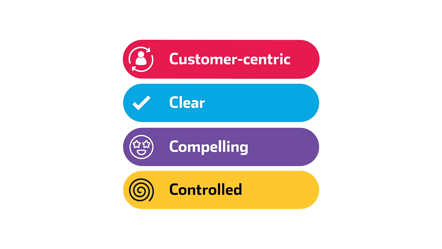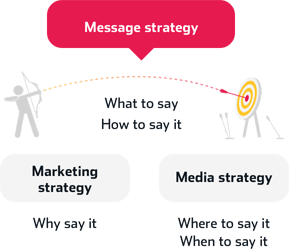needs a strategy.
needs a strategy.
Everything sends a message.
And every message needs a strategy.
Whether we’re conscious of it or not, everything (yes, everything) sends a message. Your choice of clothing sends a message. The time you show up sends a message. The food you order. The price you charge. The tone of voice you use when you answer the phone. It’s all communication. And when it comes to your brand, you should make decisions deliberately — so that the message you intend is the same message that’s received by your intended audience. Need help? Get yourself a counterpart for that.
Message strategy vs. top marketing trends
Marketing techniques come and go, but message strategy is timeless. It drives every marketing effort, whether it’s the “latest thing” or not. Here are some examples.
Strategic plans
Can you put your organization’s entire strategy into a one-page graphic? Message strategy can do it for you. You start by breaking down identity, foundation, and focus.
Positioning statements
and value propositionsPositioning is the first breath of Baby Brand. Or, it’s the inspiration that helps wayward brands be born again. This is message strategy at the big-picture, foundational level.
Vision and mission
statementsYour first message is the message to your organization. But what’s the difference between a vision and a mission? Should a vision be achievable? There are answers.
Brand name and
tagline developmentA brand has to satisfy internal agendas, be obvious in meaning yet odd enough to trademark, plus have longevity. There’s nothing more “message strategy” than that.
Customer journey
mappingMessage strategy is the GPS of the customer journey. It’s the way you guide your prospects from the first step of the buying process to the last.
Search engine
optimization (SEO)If you can’t be found, nothing else matters. But SEO is about much more than getting noticed. It’s about making your message relevant. The choice of words is strategic.
Segment marketing
Successful segmentation is about tailoring. Message strategy is how you arm your sales force to address each segment (and role) in a specific and relevant way.
Content marketing
Today, you show your expertise by sharing your expertise. But are you sharing too much? Too little? Do you plan the work and work the plan? What does your tone say?
Thought leadership
A leader takes you places you wouldn’t (or couldn’t) go on your own. So the strategy for thought leadership is building content around ideas, insights, and inspiration.
Storytelling
Maybe the #1 most misunderstood marketing approach. Nothing’s more persuasive than storytelling. But which stories to tell? Message strategy helps you decide.
User experience design
At least half of a user’s experience is what you’re communicating to them — giving them the information they need and an understanding of how to interact with you.
Graphic design
Every decision a designer makes is made with a message in mind. Which color? Image? Font? They’re all chosen deliberately. Based on the message.
Any of this on your to-do list? Count on Counterpart to help you do it right — so you won’t have to redo it later.
Send us a message, and we’ll share some examples that’ll get your juices flowing.
How to develop an effective message strategy
At Counterpart we have a saying: “The audience is Point A.” If you want to create an effective message strategy, start with your prospect. Get inside their head. See the world through their eyes. Learn not only what they need, but also how they feel, and what options they have. There’s no substitute for doing this work. You have to empathize before you engage. That’s the secret.
Of course, Counterpart has more than sayings. We have methods. Because discipline is how we ensure consistent results. Following are four examples.
Single Slide Strategy™: For vision, mission, belief, values, and standards
Single-Slide Strategy™ is a framework that helps you articulate the guiding principles of your organization. It’s simple and visual; it connects and flows. Plus it helps clear up — once and for all — the common confusion about such lofty notions as vision, mission, and “start with why.” From context to customer experience, you’ll get your foundational ideas on one slide. And we’ll give you just the right words to make it understandable, memorable, and inspiring.
The Position X® process: For positioning statements and value propositions
What makes for a successful marketplace positioning? We believe it must meet four standards: believable, ownable, desirable, and supportable. That’s the premise of Position X™ — a systematic method of firsthand research, interpreted and drawn to a directional conclusion, then crafted into a final positioning statement. This can be further translated into value propositions for every stakeholder and segment, internal and external.
The Counterpart Brief™: For project-level message strategy
Creative briefs are a marcomm convention, but ours is unlike any you’ve ever seen. It’s the product of nine months of contemplation — studying briefs from other agencies (we have a collection) and then reimagining the process from the ground up. The resulting Counterpart Brief™ gives you an entirely fresh perspective — because it’s a dual perspective. This unique approach instills a deeper understanding of the target audience — arming you with more relevant and impactful messages.
Journey GPS™: For planning customer-centric marketing campaigns
You’ve seen a one-page plan before, but not one like this. Journey GPS™ maps all of your tactics across the customer journey. Why does this matter? Because it never lets us forget that we are orchestrating media to drive customer behavior. That’s the whole point, right? And by the way, our view of the customer journey is different than most. No flipping back and forth between a customer’s perspective and a marketer’s perspective. Journey GPS™ is customer-centric from beginning to end.
Counterpart’s disciplined approach to message strategy is like nothing I’ve ever experienced from any other agency. Their brief process, in particular, is a true game-changer! It literally guided my thoughts and allowed me to focus on what truly matters. It has had a profound impact on my ability to reach my clients.
FedEx Trade Networks, Wright Medical, Carrie Perry Coaching & Consulting
Every industry needs
message strategy.
Some more than others.
Find out how Counterpart’s expertise is
especially beneficial in certain sectors.
Is your communication vain, vague, dull, and undisciplined?
Counterpart exists to help you create customer-centric communication that’s clear, compelling, and
controlled.




